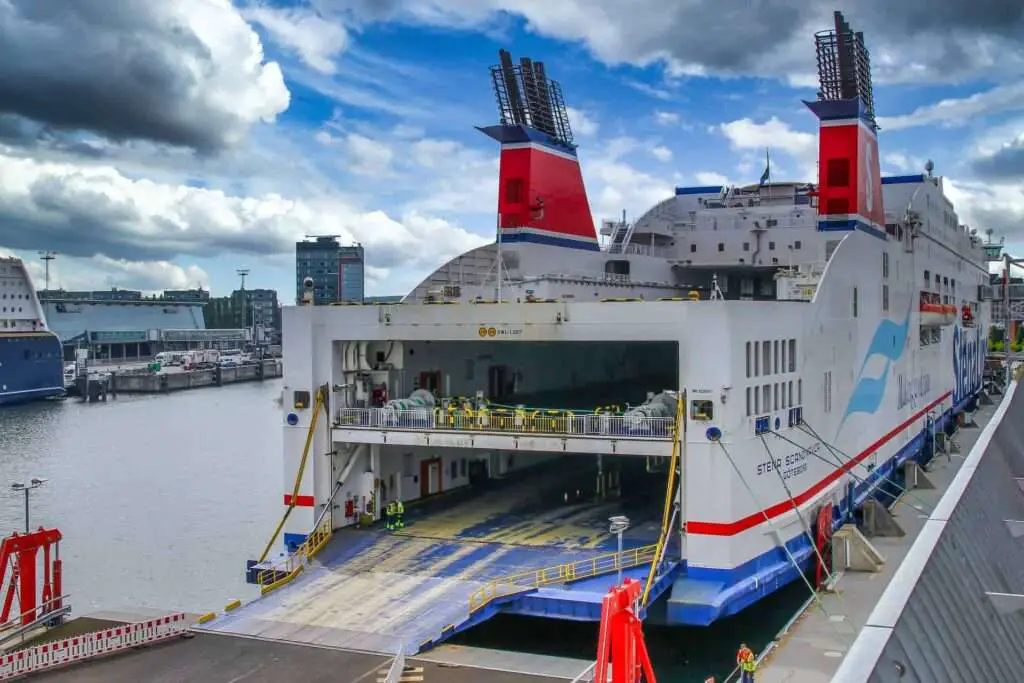
What is a ramp on a ship?
A ramp on a ship, also known as a vessel loading ramp, is a structure that allows for the efficient and safe loading and unloading of cargo onto and off of a ship.
It serves as a bridge between the ship and the port or dock, providing a smooth transition for the movement of goods.
How do loading ramps work?
These ramps are typically made of durable materials such as steel or aluminum to withstand heavy loads and harsh maritime conditions.
Loading ramps are attached to the vessel’s deck and can be raised or lowered to the desired height, depending on the dock or port where the ship is being loaded or unloaded.
They are usually equipped with hydraulic systems or winches that allow for easy adjustment of the ramp’s angle and position.
When a vessel arrives at a port, the loading ramp is positioned and secured to ensure stability during the loading or unloading process. Trucks or other vehicles can then drive onto the ramp and safely transport the cargo between the ship and the shore.
Types of Ramps
There are two different ramp designs: hydraulically driven ramps and electrically powered ramps.
Hydraulically operated ramps
Hydraulically operated ramp, which uses hydraulic power to extend and retract the ramp. This type of ramp offers greater flexibility in terms of positioning and adjusting the ramp to match the height of the vessel’s deck.
Hydraulically operated ramps are commonly found on RORO (Roll-on/Roll-off) ships, where vehicles can drive directly onto the ship for transportation.
Electrically powered ramps
Electrically operated ramp, powered by electricity, provides efficient loading and unloading of cargo. These ramps are often used in ports and terminals where there is a high volume of cargo to be loaded onto ships.
What is folding ramp?
A folding ramp, as the name suggests, is a type of vessel loading ramp that can be folded into a compact size for easy storage and transportation. This ramp is specifically designed for ships and vessels that require occasional loading and unloading of cargo.
Folding ramps are often made from high-strength materials such as aluminum, steel, or fiberglass, and can be used for loading and unloading cargo, vehicles, and equipment.
These ramps are especially useful for smaller vessels, where storage space is limited and the ramp needs to be compact when not in use.
Also Read:
What are ramps on a RoRo ship?
RORO ramps are specifically designed to accommodate the weight and dimensions of various vehicles, including cars, trucks, and even heavy machinery.
These ramps are typically inclined to allow vehicles to drive on and off the ship effortlessly.
Here is a good video about ramp on a RoRo ship
What angle should a loading ramp be?
Typically, a loading ramp should be angled between 5 to 15 degrees to allow for safe and efficient loading and unloading. If the ramp is too steep, it can make it challenging for the cargo to be safely moved, causing damage to both the cargo and the ramp.
Weather conditions such as wind and rain should also be considered when choosing the appropriate angle for the ramp. Extreme weather conditions can impact the ramp’s stability and increase the risk of accidents.
What is a barge ramp?
A barge ramp is a specialized loading ramp that is designed to facilitate the loading and unloading of cargo from barges. These ramps are typically built on a pier or dock and are designed to extend over the water’s surface, allowing barges to be loaded or unloaded directly from the dock.
Barge ramps are used primarily for bulk cargo, such as coal, grain, or other dry goods, as well as for larger vehicles and equipment. They can be either fixed or movable, with some models capable of being raised and lowered to accommodate different water levels.
One of the key advantages of using a barge ramp is that it can provide direct access to a dock or pier without the need for additional equipment, such as cranes or conveyor systems.
Gangway vs Ramp
A gangway is typically a narrow walkway that is hinged to the side of the vessel and can be lowered to the dock. It is designed to be flexible and move with the ship in the water.
On the other hand, a ramp is a solid structure that is used for loading and unloading vehicles or cargo onto or off of a vessel.
A gangway is typically used to allow passengers or crew members to board or disembark a ship safely. It can also be used to load and unload small items or equipment. In contrast, a ramp is typically used for vehicles or cargo and can handle much heavier loads.
What is the difference between the apron and the cargo ramp?
The apron is a flat, sloping surface that connects the vessel’s main deck to the loading ramp. It is typically made of steel and serves as a transition area for cargo moving from the main deck to the ramp.
The cargo ramp, on the other hand, is the movable structure that extends from the apron to the dock. It can be raised and lowered to accommodate different levels of the dock and is designed to support the weight of heavy cargo.
The apron provides a stable surface for workers and vehicles to move between the main deck and ramp, while the cargo ramp provides a secure and safe route for the cargo to be transferred from the vessel to the dock.
